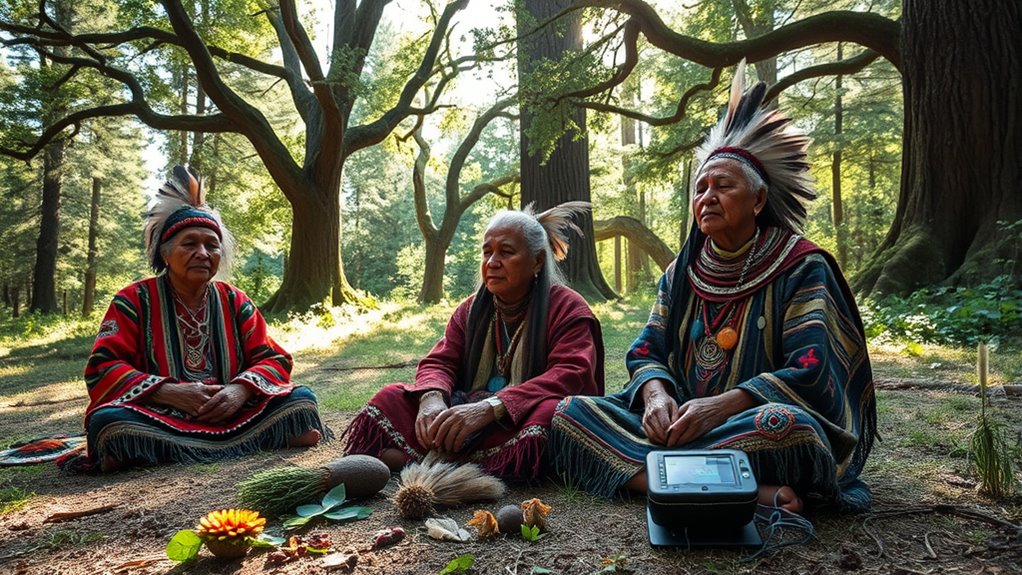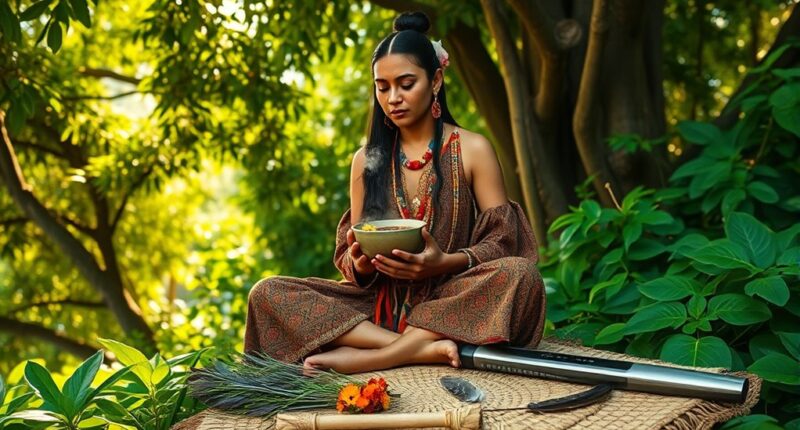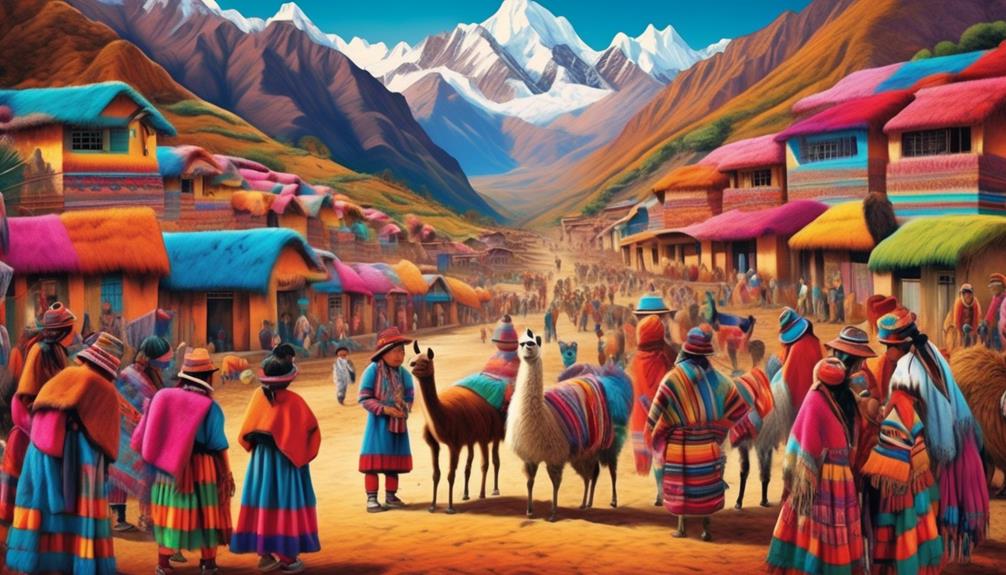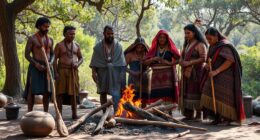Indigenous wellness practices combine herbal remedies, spiritual ceremonies, and community support, focusing on holistic health. Modern science is increasingly validating many traditional herbs for their active compounds and healing properties, while rituals help strengthen emotional, spiritual, and social well-being. Environmental factors like lighting and setting also enhance healing effects. If you explore further, you’ll discover how these time-honored traditions are gaining recognition for their role in promoting resilience and overall health.
Key Takeaways
- Traditional herbal remedies are being scientifically studied for active compounds with potential medicinal benefits.
- Rituals and environmental adjustments, like color therapy, enhance the healing environment, supported by scientific research.
- Indigenous practices promote mental health by reducing stress and anxiety through cultural and spiritual rituals.
- Community-based healing methods strengthen social cohesion, contributing to overall well-being validated by modern studies.
- Herbal medicines used in indigenous practices are increasingly validated for safety and efficacy through scientific investigations.

Have you ever wondered how Indigenous communities maintain holistic well-being through centuries-old practices? It’s fascinating to see how their approach to health incorporates more than just physical treatment—it’s about harmony of the mind, body, and spirit. Traditional healing plays a central role here, often intertwined with cultural rituals that have been handed down through generations. These rituals aren’t just symbolic; they serve as powerful tools for restoring balance and fostering resilience within communities. When you participate in or observe these practices, you realize that healing isn’t solely about curing symptoms but about nurturing the whole person in connection with their environment and ancestors.
Traditional healing methods often involve a combination of herbal remedies, spiritual ceremonies, and community support. Indigenous healers, sometimes called shamans, act as mediators between the physical and spiritual worlds. They use plant-based medicines backed by centuries of experiential knowledge, which modern science is beginning to validate. For example, certain herbs traditionally used for inflammation or pain are now being studied for their active compounds, revealing potential for developing new medicines. But what makes these practices truly effective isn’t just the herbs; it’s the cultural rituals that frame their use. These rituals, whether they involve singing, dancing, or prayers, create a sacred space that enhances the healing process by aligning individuals with their cultural identity and spiritual roots. Additionally, research into color temperature adjustments shows that environmental factors can influence the effectiveness of healing environments, highlighting the importance of setting in traditional practices.
Cultural rituals serve multiple purposes—they reaffirm community bonds, transmit ancestral wisdom, and facilitate emotional healing. When you witness or take part in these ceremonies, you see how they foster a sense of belonging and purpose, which are essential for overall well-being. The rituals often incorporate elements like sacred objects, specific chants, or movements that have symbolic meanings rooted in Indigenous cosmology. Scientific research supports this, showing that such rituals can lower stress levels, improve mental health, and strengthen social cohesion. These effects contribute to a holistic sense of wellness, confirming that healing is not just physical but also emotional and spiritual.
Frequently Asked Questions
How Do Indigenous Wellness Practices Influence Mental Health?
You might find that indigenous wellness practices positively influence your mental health by strengthening cultural resilience and providing a sense of identity. Participating in traditional ceremonies can offer community support, reduce stress, and foster emotional healing. These practices help you connect with your roots, promoting resilience against mental health challenges. By embracing such traditions, you create a foundation for mental well-being rooted in cultural strength and shared experiences.
Are There Specific Indigenous Practices Proven to Reduce Stress?
You might wonder if specific indigenous practices truly reduce stress. Traditional ceremonies, like sweat lodges or drumming, have been shown to promote relaxation and emotional release. Herbal remedies used in indigenous medicine can also calm the nervous system, easing anxiety. Modern science supports these practices, confirming their effectiveness. By engaging in these rituals or using herbal remedies, you can tap into time-tested methods that help lower stress and improve overall well-being.
Can These Practices Be Integrated Into Western Healthcare?
You can integrate indigenous practices into Western healthcare by respecting cultural preservation and incorporating traditional ceremonies. These practices, supported by modern science, show benefits like reduced stress and improved well-being. When you collaborate with indigenous communities, you ensure authenticity and respect. By blending these approaches, you create a more holistic healthcare system that honors cultural identities while promoting health through proven traditional methods.
What Scientific Methods Validate Indigenous Healing Techniques?
You can explore how scientific methods validate indigenous healing techniques by examining research on traditional herbalism and ceremonial healing. Scientists use clinical trials, biochemical analyses, and ethnobotanical studies to assess the safety and efficacy of these practices. By documenting active compounds in medicinal plants and measuring health outcomes, they provide evidence that supports indigenous methods, fostering integration into mainstream healthcare while respecting cultural traditions.
How Accessible Are Indigenous Wellness Practices to Non-Indigenous Communities?
Think of indigenous wellness practices as hidden gems waiting to be discovered. You might find traditional ceremonies open to community participation or accessible workshops that celebrate cultural preservation. While some communities actively share these practices, others protect them fiercely. Your journey involves respecting these traditions, seeking authentic experiences, and understanding their cultural significance. Accessibility varies, but with genuine respect and curiosity, you can engage meaningfully and help honor indigenous knowledge.
Conclusion
By embracing indigenous wellness practices backed by modern science, you can cultivate a clearer, calmer, and more connected consciousness. These time-tested traditions teach you to tune into nature, nurture your nerves, and trust in timeless techniques. When you prioritize this powerful, proven path, you empower your body and balance your mind. So, step into this sacred synergy of science and spirit, and discover the dynamic, delightful difference it can make in your daily life.









